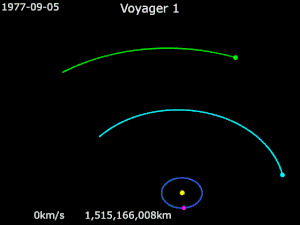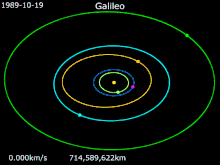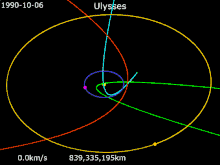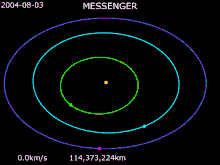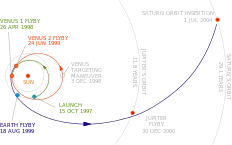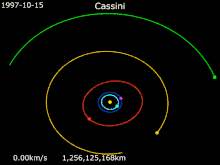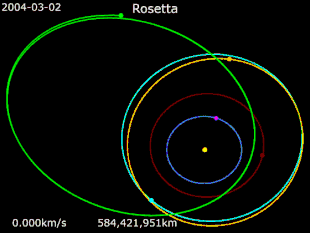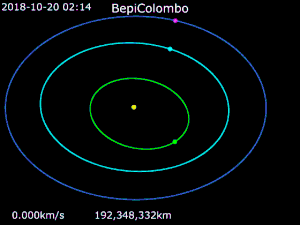Gravity assist
In orbital mechanics and aerospace engineering, a gravitational slingshot, gravity assist maneuver, or swing-by is the use of the relative movement (e.g. orbit around the Sun) and gravity of a planet or other astronomical object to alter the path and speed of a spacecraft, typically to save propellant and reduce expense.
| Part of a series on |
| Astrodynamics |
|---|
 |
|
Celestial mechanics |
|
Engineering and efficiency |
Gravity assistance can be used to accelerate a spacecraft, that is, to increase or decrease its speed or redirect its path. The "assist" is provided by the motion of the gravitating body as it pulls on the spacecraft.[1] Any gain or loss of kinetic energy and velocity by a passing spacecraft is correspondingly lost or gained by the gravitational body, in accordance with Newton's Third Law. The gravity assist maneuver was first used in 1959 when the Soviet probe Luna 3 photographed the far side of Earth's Moon and it was used by interplanetary probes from Mariner 10 onwards, including the two Voyager probes' notable flybys of Jupiter and Saturn.
Explanation
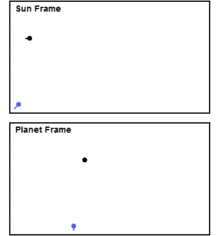
In the planet's frame of reference, the space probe leaves with the exact same speed at which it had arrived. But when observed in the reference frame of the Solar System (fixed to the Sun), the benefit of this maneuver becomes apparent. Here it can be seen how the probe gains speed by tapping energy from the speed of the planet as it orbits the Sun. (If the trajectory is designed to pass in front of the planet instead of behind it, the gravity assist can be used as a braking maneuver rather than accelerating.) Because the mass of the probe is many orders of magnitude smaller than that of the planet, while the result on the probe is quite significant, the deceleration reaction experienced by the planet, according to Newton's third law, is utterly imperceptible.
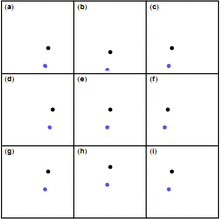
A gravity assist around a planet changes a spacecraft's velocity (relative to the Sun) by entering and leaving the gravitational sphere of influence of a planet. The spacecraft's speed increases as it approaches the planet and decreases as it leaves the planet. The speed gained from approaching and the speed lost from leaving is nearly identical, but the spacecraft is affected by the planet's motion around the sun during the maneuver. To increase speed, the spacecraft approaches the planet from the direction of the planet's orbital velocity, and departs in the opposite direction. To decrease speed, the spacecraft approaches the planet from a direction away from the planet's orbital velocity – in both types of maneuver the energy transfer compared to the planet's total orbital energy is negligible. The sum of the kinetic energies of both bodies remains constant (see elastic collision). A slingshot maneuver can therefore be used to change the spaceship's trajectory and speed relative to the Sun.
A close terrestrial analogy is provided by a tennis ball bouncing off the front of a moving train. Imagine standing on a train platform, and throwing a ball at 30 km/h toward a train approaching at 50 km/h. The driver of the train sees the ball approaching at 80 km/h and then departing at 80 km/h after the ball bounces elastically off the front of the train. Because of the train's motion, however, that departure is at 130 km/h relative to the train platform; the ball has added twice the train's velocity to its own.[3]
Translating this analogy into space: in the planet reference frame, the spaceship has a vertical velocity of v relative to the planet. After the slingshot occurs the spaceship is leaving on a course 90 degrees to that which it arrived on. It will still have a velocity of v, but in the horizontal direction.[2] In the Sun reference frame, the planet has a horizontal velocity of v, and by using the Pythagorean Theorem, the spaceship initially has a total velocity of √2v. After the spaceship leaves the planet, it will have a velocity of v + v = 2v, gaining approximately 0.6v.[2]
This oversimplified example is impossible to refine without additional details regarding the orbit, but if the spaceship travels in a path which forms a hyperbola, it can leave the planet in the opposite direction without firing its engine. This example is one of many trajectories and gains of speed the spaceship can experience.
This explanation might seem to violate the conservation of energy and momentum, apparently adding velocity to the spacecraft out of nothing, but the spacecraft's effects on the planet must also be taken into consideration to provide a complete picture of the mechanics involved. The linear momentum gained by the spaceship is equal in magnitude to that lost by the planet, so the spacecraft gains velocity and the planet loses velocity. However, the planet's enormous mass compared to the spacecraft makes the resulting change in its speed negligibly small even when compared to the orbital perturbations planets undergo due to interactions with other celestial bodies on astronomically short timescales. For example, one metric ton is a typical mass for an interplanetary space probe whereas Jupiter has a mass of almost 2 x 1024 metric tons. Therefore, a one-ton spacecraft passing Jupiter will theoretically cause the planet to lose approximately 5 x 10−25 km/s of orbital velocity for every km/s of velocity relative to the Sun gained by the spacecraft. For all practical purposes the effects on the planet can be ignored in the calculation.[4]
Realistic portrayals of encounters in space require the consideration of three dimensions. The same principles apply as above except adding the planet's velocity to that of the spacecraft requires vector additionas shown below.
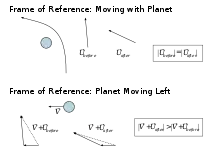
Due to the reversibility of orbits, gravitational slingshots can also be used to reduce the speed of a spacecraft. Both Mariner 10 and MESSENGER performed this maneuver to reach Mercury.
If more speed is needed than available from gravity assist alone, a rocket burn near the periapsis (closest planetary approach) uses the least fuel. A given rocket burn always provides the same change in velocity (Δv), but the change in kinetic energy is proportional to the vehicle's velocity at the time of the burn. Therefore the maximum kinetic energy is obtained when the burn occurs at the vehicle's maximum velocity (periapsis). The Oberth effect describes this technique in more detail.
Historical origins
In his paper "To those who will be reading in order to build" ("Тем, кто будет читать, чтобы строить"),[5] published in 1938 but dated 1918–1919,[lower-alpha 1] Yuri Kondratyuk suggested that a spacecraft traveling between two planets could be accelerated at the beginning and end of its trajectory by using the gravity of the two planets' moons. The portion of his manuscript considering gravity-assists received no later development and was not published until the 1960s.[6] In his 1925 paper "Problems of flight by jet propulsion: interplanetary flights" ("Проблема полета при помощи реактивных аппаратов: межпланетные полеты"),[7] Friedrich Zander showed a deep understanding of the physics behind the concept of gravity assist and its potential for the interplanetary exploration of the solar system.[6]
Italian engineer Gaetano Crocco was first to calculate an interplanetary journey considering multiple gravity-assists.[6]
The gravity assist maneuver was first attempted in 1959 when the Soviet probe Luna 3 photographed the far side of the Moon. The maneuver relied on research performed under the direction of Mstislav Keldysh at the Keldysh Institute of Applied Mathematics.[8][9][10]
During the summer of 1964 at the NASA Jet Propulsion Laboratory (JPL), Gary Flandro was assigned the task of studying techniques for exploring the outer planets of the solar system. In this study he discovered the rare alignment of the outer planets (Jupiter, Saturn, Uranus, and Neptune) and conceived the Planetary Grand Tour multi-planet mission utilizing gravity assist to reduce mission duration from forty years to less than ten.[11]
Purpose
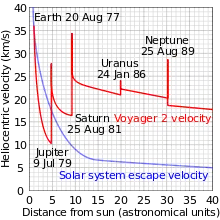
A spacecraft traveling from Earth to an inner planet will increase its relative speed because it is falling toward the Sun, and a spacecraft traveling from Earth to an outer planet will decrease its speed because it is leaving the vicinity of the Sun.
Although the orbital speed of an inner planet is greater than that of the Earth, a spacecraft traveling to an inner planet, even at the minimum speed needed to reach it, is still accelerated by the Sun's gravity to a speed notably greater than the orbital speed of that destination planet. If the spacecraft's purpose is only to fly by the inner planet, then there is typically no need to slow the spacecraft. However, if the spacecraft is to be inserted into orbit about that inner planet, then there must be some way to slow it down.
Similarly, while the orbital speed of an outer planet is less than that of the Earth, a spacecraft leaving the Earth at the minimum speed needed to travel to some outer planet is slowed by the Sun's gravity to a speed far less than the orbital speed of that outer planet. Therefore, there must be some way to accelerate the spacecraft when it reaches that outer planet if it is to enter orbit about it.
Rocket engines can certainly be used to increase and decrease the speed of the spacecraft. However, rocket thrust takes propellant, propellant has mass, and even a small change in velocity (known as Δv, or "delta-v", the delta symbol being used to represent a change and "v" signifying velocity) translates to a far larger requirement for propellant needed to escape Earth's gravity well. This is because not only must the primary-stage engines lift the extra propellant, they must also lift the extra propellant beyond that which is needed to lift that additional propellant. The liftoff mass requirement increases exponentially with an increase in the required delta-v of the spacecraft.
Because additional fuel is needed to lift fuel into space, space missions are designed with a tight propellant "budget", known as the "delta-v budget". The delta-v budget is in effect the total propellant that will be available after leaving the earth, for speeding up, slowing down, stabilization against external buffeting (by particles or other external effects), or direction changes, if it cannot acquire more propellant. The entire mission must be planned within that capability. Therefore, methods of speed and direction change that do not require fuel to be burned are advantageous, because they allow extra maneuvering capability and course enhancement, without spending fuel from the limited amount which has been carried into space. Gravity assist maneuvers can greatly change the speed of a spacecraft without expending propellant, and can save significant amounts of propellant, so they are a very common technique to save fuel.
Limits

The main practical limit to the use of a gravity assist maneuver is that planets and other large masses are seldom in the right places to enable a voyage to a particular destination. For example, the Voyager missions which started in the late 1970s were made possible by the "Grand Tour" alignment of Jupiter, Saturn, Uranus and Neptune. A similar alignment will not occur again until the middle of the 22nd century. That is an extreme case, but even for less ambitious missions there are years when the planets are scattered in unsuitable parts of their orbits.
Another limitation is the atmosphere, if any, of the available planet. The closer the spacecraft can approach, the faster its periapsis speed as gravity accelerates the spacecraft, allowing for more kinetic energy to be gained from a rocket burn. However, if a spacecraft gets too deep into the atmosphere, the energy lost to drag can exceed that gained from the planet's gravity. On the other hand, the atmosphere can be used to accomplish aerobraking. There have also been theoretical proposals to use aerodynamic lift as the spacecraft flies through the atmosphere. This maneuver, called an aerogravity assist, could bend the trajectory through a larger angle than gravity alone, and hence increase the gain in energy.
Even in the case of an airless body, there is a limit to how close a spacecraft may approach. The magnitude of the achievable change in velocity depends on the spacecraft's approach velocity and the planet's escape velocity at the point of closest approach (limited by either the surface or the atmosphere.)
Interplanetary slingshots using the Sun itself are not possible because the Sun is at rest relative to the Solar System as a whole. However, thrusting when near the Sun has the same effect as the powered slingshot described as the Oberth effect. This has the potential to magnify a spacecraft's thrusting power enormously, but is limited by the spacecraft's ability to resist the heat.
A rotating black hole might provide additional assistance, if its spin axis is aligned the right way. General relativity predicts that a large spinning mass produces frame-dragging—close to the object, space itself is dragged around in the direction of the spin. Any ordinary rotating object produces this effect. Although attempts to measure frame dragging about the Sun have produced no clear evidence, experiments performed by Gravity Probe B have detected frame-dragging effects caused by Earth.[12] General relativity predicts that a spinning black hole is surrounded by a region of space, called the ergosphere, within which standing still (with respect to the black hole's spin) is impossible, because space itself is dragged at the speed of light in the same direction as the black hole's spin. The Penrose process may offer a way to gain energy from the ergosphere, although it would require the spaceship to dump some "ballast" into the black hole, and the spaceship would have had to expend energy to carry the "ballast" to the black hole.
Another application of gravity assist might be used to change the orbital distance of the earth from the sun, for cooling down earth temperature by future technology. Also, it could be done by the advanced civilizations to change the position of their habitable planets when their parent started to inflate to a giant star.[13] In this scenario, the asteroids in the asteroid belt are guided with the solar sails and propulsion engines to have energy loss scattering which provides positive energy to the earth and increases the orbital distance.
Tisserand parameter and gravity assists
The use of gravity assists is constrained by a conserved quantity called the Tisserand parameter (or invariant). This is an approximation to the Jacobi constant of the restricted three-body problem. Considering the case of a comet orbiting the Sun and the effects a Jupiter encounter would have, Félix Tisserand showed that
will remain constant (where is the comet's semi-major axis, its eccentricity, its inclination, and is the semi-major axis of Jupiter).
This applies when the comet is sufficiently far from Jupiter to have well-defined orbital elements and to the extent that Jupiter is much less massive than the Sun and on a circular orbit.
This quantity is conserved for any system of three objects, one of which has negligible mass, and another of which is of intermediate mass and on a circular orbit. Examples are the Sun, Earth and a spacecraft, or Saturn, Titan and the Cassini spacecraft (using the semi-major axis of the perturbing body instead of ). This imposes a constraint on how a gravity assist may be used to alter a spacecraft's orbit.
The Tisserand parameter will change if the spacecraft makes a propulsive maneuver or a gravity assist of some fourth object, which is one reason that many spacecraft frequently combine Earth and Venus (or Mars) gravity assists or also perform large deep space maneuvers.
Timeline of notable examples
Luna 3
The gravity assist maneuver was first used in 1959 when Luna 3 photographed the far side of Earth's Moon.
Pioneer program
Gary Flandro's mission architecture would ultimately be accomplished in the late 1970s by the two Voyager probes, but in order to prepare for it, NASA decided in 1964 to experiment with launching a pair of probes to the outer Solar System.[14] An advocacy group named the Outer Space Panel and chaired by American space scientist James A. Van Allen, worked out the scientific rationale for exploring the outer planets.[15][16] NASA Goddard Spaceflight Center put together a proposal for a pair of "Galactic Jupiter Probes" that would pass through the asteroid belt and visit Jupiter. These were to be launched in 1972 and 1973 during favorable windows that occurred only a few weeks every 13 months. Launch during other time intervals would have been more costly in terms of propellant requirements.[17]
Approved by NASA in February 1969,[17] the twin spacecraft were designated Pioneer F and Pioneer G before launch; later they were named Pioneer 10 and Pioneer 11. They formed part of the Pioneer program,[18] a series of United States unmanned space missions launched between 1958 and 1978. This model was the first in the series to be designed for exploring the outer Solar System. Based on multiple proposals issued throughout the 1960s, the early mission objectives were to explore the interplanetary medium past the orbit of Mars, study the asteroid belt and assess the possible hazard to spacecraft traveling through the belt, and explore Jupiter and its environment.[19] Later development-stage objectives included the probe closely approaching Jupiter to provide data on the effect the environmental radiation surrounding Jupiter would have on the spacecraft instruments.
Pioneer 10
NASA's Pioneer 10 is a space probe launched in 1972 that completed the first mission to the planet Jupiter.[20] Thereafter, Pioneer 10 became the first of five artificial objects to achieve the escape velocity needed to leave the Solar System.
In December 1973, Pioneer 10 spacecraft was the first one to use the gravitational slingshot effect to reach escape velocity to leave Solar System.
Pioneer 11
Pioneer 11 (also known as Pioneer G) is a 260-kilogram (570 lb) robotic space probe launched by NASA on April 6, 1973, to study the asteroid belt, the environment around Jupiter and Saturn, solar winds, and cosmic rays.[20] It was the first probe to encounter Saturn, the second to fly through the asteroid belt, and the second to fly by Jupiter. Later, Pioneer 11 became the second of five artificial objects to achieve an escape velocity allowing it to leave the Solar System. Due to power constraints and the vast distance to the probe, the last routine contact with the spacecraft was on September 30, 1995, and the last good engineering data was received on November 24, 1995.[21][22]
Mariner 10
The Mariner 10 probe was the first spacecraft to use the gravitational slingshot effect to reach another planet, passing by Venus on 5 February 1974 on its way to becoming the first spacecraft to explore Mercury.
Voyager
Gary Flandro's work was exploited by NASA with the Voyager 1 and Voyager 2 missions, launched in 1977.[23][24]
Voyager 1
Voyager 1 is a space probe that was launched by NASA on September 5, 1977. Part of the Voyager program to study the outer Solar System, Voyager 1 was launched 16 days after its twin, Voyager 2. It gained the energy to escape the Sun's gravity completely by performing slingshot maneuvers around Jupiter and Saturn.[25] Having operated for 45 years, 1 month and 28 days as of November 2, 2022 UTC [refresh], the spacecraft still communicates with the Deep Space Network to receive routine commands and to transmit data to Earth. Real-time distance and velocity data is provided[26] by NASA and JPL. At a distance of 152.2 AU (22.8 billion km; 14.1 billion mi) from Earth as of January 12, 2020,[27] it is the most distant human-made object from Earth.[28]
The probe's objectives included flybys of Jupiter, Saturn, and Saturn's largest moon, Titan. Although the spacecraft's course could have been altered to include a Pluto encounter by forgoing the Titan flyby, exploration of the moon took priority because it was known to have a substantial atmosphere.[29][30][31] Voyager 1 studied the weather, magnetic fields, and rings of the two planets, and was the first probe to provide detailed images of their moons.
As part of the Voyager program, like its sister craft Voyager 2, the spacecraft is in an extended mission to locate and study the regions and boundaries of the outer heliosphere, and to begin exploring the interstellar medium. Voyager 1 crossed the heliopause and entered interstellar space on August 25, 2012, making it the first spacecraft to do so.[32][33] Two years later, Voyager 1 began experiencing a third "tsunami wave" of coronal mass ejections from the Sun, that has continued to at least December 15, 2014, further confirming that the probe is indeed in interstellar space.[34]
In a further testament to the robustness of Voyager 1, the Voyager team tested the spacecraft's trajectory correction maneuver (TCM) thrusters in late 2017 (the first time these thrusters had been fired since 1980), a project enabling the mission to be extended by two to three years.[35] Voyager 1's extended mission is expected to continue until about 2025, when its radioisotope thermoelectric generators (RTGs) will no longer supply enough electric power to operate its scientific instruments.[36] As of 24 May 2022, Voyager 1 is about 156.5 AU from the Sun, or 21.5 light hours.[37]
Voyager 2
Voyager 2 is a space probe launched by NASA on August 20, 1977, to study the outer planets. A part of the Voyager program, it was launched 16 days before its twin, Voyager 1, on a trajectory that took longer to reach Jupiter and Saturn but enabled further encounters with Uranus and Neptune.[38] It remains the only spacecraft to have visited either of these two ice giant planets, much less both. Voyager 2 was the fourth of five spacecraft to achieve the Solar escape velocity, which allowed it to leave the Solar System.
Its primary mission ended with the exploration of the Neptunian system on October 2, 1989, after having visited the Jovian system in 1979, the Saturnian system in 1981, and the Uranian system in 1986. Voyager 2 is now in its extended mission to study Interstellar Space and has been operating for 45 years, 2 months and 13 days as of November 2, 2022. It remains in contact through the NASA Deep Space Network.[39] Maintenance to the Deep Space Network created the longest period of silence in outbound communications to the probe for a period of 8 months. Contact was reestablished on November 2, 2020, when a series of instructions was transmitted, subsequently executed and relayed back with a successful communication message.[40] As of February 12, 2021, full communications with the probe was restored after a major antenna upgrade that took a year to complete. The DSS 43 communication antenna, solely responsible for communications with the probe, is located in Canberra, Australia.[41]
On November 5, 2018, at a distance of 122 AU (1.83×1010 km) (about 16:58 light-hours)[42] from the Sun,[43] moving at a velocity of 15.341 km/s (55,230 km/h)[37] relative to the Sun, Voyager 2 left the heliosphere, and entered the interstellar medium (ISM), a region of outer space beyond the influence of the Solar System, joining Voyager 1 which had reached the interstellar medium in 2012.[44][45][46][47] Voyager 2 has begun to provide the first direct measurements of the density and temperature of the interstellar plasma.[48] As of 24 May 2022, Voyager 2 is currently almost 130.3 AU from the Sun, or 18 light hours.[37]
Galileo
The Galileo spacecraft was launched by NASA in 1989 aboard Space Shuttle Atlantis. Its original mission was designed to use a direct Hohmann transfer. However, Galileo's intended booster, the cryogenically fueled Centaur booster rocket was prohibited as a Shuttle "cargo" for safety considerations following the loss of Space Shuttle Challenger. With its substituted solid rocket upper stage, the IUS, which could not provide as much delta-v, Galileo did not ascend directly to Jupiter, but flew by Venus once and Earth twice in order to reach Jupiter in December 1995. This also allowed Galileo to flyby two asteroids, 243 Ida and 951 Gaspra.
The Galileo engineering review speculated (but was never able to prove conclusively) that this longer flight time coupled with the stronger sunlight near Venus caused lubricant in Galileo's main antenna to fail, forcing the use of a much smaller backup antenna with a consequent lowering of data rate from the spacecraft.
Its subsequent tour of the Jovian moons also used numerous slingshot maneuvers with those moons to conserve fuel and maximize the number of encounters.
Ulysses
In 1990, NASA launched the ESA spacecraft Ulysses to study the polar regions of the Sun. All the planets orbit approximately in a plane aligned with the equator of the Sun. Thus, to enter an orbit passing over the poles of the Sun, the spacecraft would have to eliminate the 30 km/s speed it inherited from the Earth's orbit around the Sun and gain the speed needed to orbit the Sun in the pole-to-pole plane, tasks that are impossible with current spacecraft propulsion systems alone, making gravity assist maneuvers essential.
Accordingly, Ulysses was first sent toward Jupiter and aimed to arrive at a point in space just ahead and south of the planet. As it passed Jupiter, the probe fell through the planet's gravity field, exchanging momentum with the planet. The gravity assist maneuver bent the probe's trajectory northward relative to the Ecliptic Plane onto an orbit which passes over the poles of the Sun. By using this maneuver, Ulysses needed only enough propellant to send it to a point near Jupiter, which was well within capability.
MESSENGER
The MESSENGER mission (launched in August 2004) made extensive use of gravity assists to slow its speed before orbiting Mercury. The MESSENGER mission included one flyby of Earth, two flybys of Venus, and three flybys of Mercury before finally arriving at Mercury in March 2011 with a velocity low enough to permit orbit insertion with available fuel. Although the flybys were primarily orbital maneuvers, each provided an opportunity for significant scientific observations.
Cassini
The Cassini–Huygens spacecraft passed by Venus twice, then Earth, and finally Jupiter on the way to Saturn. The 6.7-year transit was slightly longer than the six years needed for a Hohmann transfer, but cut the extra velocity (delta-v) needed to about 2 km/s, so that the large and heavy Cassini probe was able to reach Saturn, which would not have been possible in a direct transfer even with the Titan IV, the largest launch vehicle available at the time. A Hohmann transfer to Saturn would require a total of 15.7 km/s delta-v (disregarding Earth's and Saturn's own gravity wells, and disregarding aerobraking), which is not within the capabilities of even current launch vehicles and spacecraft propulsion systems.
After entering orbit around Saturn, the Cassini spacecraft used multiple Titan gravity assists to navigate through a complex orbital tour. A typical Titan encounter changed the spacecraft's velocity by 0.75 km/s, and the spacecraft made 127 Titan encounters. These encounters enabled an orbital tour with a wide range of periapsis and apoapsis distances, various alignments of the orbit with respect to the Sun, and orbital inclinations from 0° to 74°. The multiple flybys of Titan also allowed Cassini to flyby other moons, such as Rhea and Enceladus.
Rosetta
The Rosetta probe, launched in March 2004, used four gravity assist maneuvers (including one just 250 km from the surface of Mars) to accelerate throughout the inner Solar System. That enabled it to flyby the asteroids 21 Lutetia and 2867 Šteins as well as eventually match the velocity of the 67P/Churyumov–Gerasimenko comet at the rendezvous point in August 2014.
Juno
The Juno spacecraft was launched on August 5, 2011 (UTC). The trajectory used a gravity assist speed boost from Earth, accomplished by an Earth flyby in October 2013, two years after its launch on August 5, 2011.[49] In that way Juno changed its orbit (and speed) toward its final goal, Jupiter, after only five years.
Parker Solar Probe
NASA's Parker Solar Probe mission, launched in 2018, is using multiple gravity assists at Venus to remove the Earth's angular momentum from the orbit to drop to a perihelion distance of 8.5 solar radii (5.9 Gm) from the Sun, or about 0.04 AU. Parker Solar Probe's mission will make the closest approach to the Sun by any space mission.
BepiColombo
BepiColombo is a joint mission of the European Space Agency (ESA) and the Japan Aerospace Exploration Agency (JAXA) to the planet Mercury. It was launched on 20 October 2018. It will use the gravity assist technique with Earth once, with Venus twice, and six times with Mercury. It will arrive in 2025. BepiColombo is named after Giuseppe (Bepi) Colombo who was a pioneer thinker with this way of maneuvers.[50]
See also
- 3753 Cruithne, an asteroid which periodically has gravitational slingshot encounters with Earth
- Delta-v budget
- Low-energy transfer, a type of gravitational assist where a spacecraft is gravitationally snagged into orbit by a celestial body. This method is usually executed in the Earth-Moon system.
- Dynamical friction
- Flyby anomaly, an anomalous delta-v increase during gravity assists
- Gravitational keyhole
- Interplanetary Transport Network
- n-body problem
- New Horizons, a gravity-assisted mission (flying past Jupiter) that reached Pluto on 14 July 2015
- Oberth effect, applying thrust near closest approach in a gravity well
- Pioneer H, first Out-Of-The-Ecliptic mission (OOE) proposed, for Jupiter and solar (Sun) observations
- STEREO, a gravity-assisted mission which used Earth's Moon to eject two spacecraft from Earth's orbit into heliocentric orbit
Notes
- In 1938, when Kondratyuk submitted his manuscript "To whoever will read in order to build" for publication, he dated the manuscript 1918–1919, although it was apparent that the manuscript had been revised at various times. See page 49 of NASA Technical Translation F-9285 (1 November 1965).
References
- "Section 1: Environment, Chapter 4: Trajectories". Basics of Space Flight. NASA. Retrieved 21 July 2018.
- "Gravity assist". The Planetary Society. Retrieved 1 January 2017.
- "A Gravity Assist Primer". Basics of Space Flight. NASA. Retrieved 21 July 2018.
- Johnson, R. C. (January 2003). "The slingshot effect" (PDF). Durham University.
{{cite journal}}: Cite journal requires|journal=(help) - Kondratyuk's paper is included in the book: Mel'kumov, T. M., ed., Pionery Raketnoy Tekhniki [Pioneers of Rocketry: Selected Papers] (Moscow, U.S.S.R.: Institute for the History of Natural Science and Technology, Academy of Sciences of the USSR, 1964). An English translation of Kondratyuk's paper was made by NASA. See: NASA Technical Translation F-9285, pages 15–56 (1 November 1965).
- Negri, Rodolfo Batista; Prado, Antônio Fernando Bertachini de Alme (14 July 2020). "A historical review of the theory of gravity-assists in the pre-spaceflight era". Journal of the Brazilian Society of Mechanical Sciences and Engineering. 42 (8). doi:10.1007/s40430-020-02489-x. S2CID 220510617.
- Zander's 1925 paper, "Problems of flight by jet propulsion: interplanetary flights" was translated by NASA. See NASA Technical Translation F-147 (1964); specifically, Section 7: Flight Around a Planet's Satellite for Accelerating or Decelerating Spaceship, pages 290–292.
- Eneev, T.; Akim, E. "Mstislav Keldysh. Mechanics of the space flight" (in Russian). Keldysh Institute of Applied Mathematics.
- Egorov, Vsevolod Alexandrovich (September 1957). "Specific problems of a flight to the moon". Physics-Uspekhi. 63 (9): 73–117. doi:10.3367/UFNr.0063.195709f.0073.
- Rauschenbakh, Boris V.; Ovchinnikov, Michael Yu.; McKenna-Lawlor, Susan M. P. (2003). Essential Spaceflight Dynamics and Magnetospherics. Dordrecht, Netherlands: Kluwer Academic. pp. 146–147. ISBN 0-306-48027-1.
- Flandro, Gary. "Fast Reconnaissance Missions To The Outer Solar System Using Energy Derived From The Gravitational Field Of Jupiter" (PDF). NASA-JPL Contract #7-100. GravityAssist.com. Retrieved 28 October 2011.
- Everitt, C. W. F.; et al. (June 2011). "Gravity Probe B: Final Results of a Space Experiment to Test General Relativity". Physical Review Letters. 106 (22). 221101. arXiv:1105.3456. Bibcode:2011PhRvL.106v1101E. doi:10.1103/PhysRevLett.106.221101. PMID 21702590. S2CID 11878715.
- Rahvar, S. (2022). "Gravity-Assist as a Solution to Save Earth from Global Warming". arXiv:2201.02879.
{{cite journal}}: Cite journal requires|journal=(help) - Launius 2004, p. 36.
- Van Allen 2001, p. 155.
- Burrows 1990, pp. 16.
- Burrows 1999, p. 476.
- Burgess 1982, p. 16.
- Mark, Hans (August 1974). "The Pioneer Jupiter Mission". SP-349/396 Pioneer Odyssey. NASA. Retrieved July 6, 2011.
- Fimmel, R. O.; W. Swindell; E. Burgess (1974). SP-349/396 PIONEER ODYSSEY. NASA-Ames Research Center. SP-349/396. Retrieved January 9, 2011.
- "The Pioneer Missions". 3 March 2015.
- "Pioneer 11: In Depth". Retrieved December 10, 2017.
- Swift, David W. (1997). Voyager Tales: Personal Views of the Grand Tour. pp. 61–74. ISBN 9781563472527. OCLC 36877469. Retrieved 25 December 2016 – via Google Books.
- Riley, Christopher; Campbell, Dallas (23 October 2012). "The maths that made Voyager possible". BBC. Retrieved 25 December 2016.
- "A Gravity Assist Primer". Basics of Space Flight. NASA. Retrieved 21 July 2018.
- "Voyager - Mission Status".
- "Voyager – Mission Status". Jet Propulsion Laboratory. National Aeronautics and Space Administration. Retrieved December 26, 2019.,
- "Voyager 1". BBC Solar System. Archived from the original on February 3, 2018. Retrieved September 4, 2018.
- "Voyager – Frequently Asked Questions". NASA. February 14, 1990. Retrieved August 4, 2017.
- "New Horizons conducts flyby of Pluto in historic Kuiper Belt encounter". 12 July 2015. Retrieved September 2, 2015.
- "What If Voyager Had Explored Pluto?". Retrieved September 2, 2015.
- "Interstellar Mission". NASA Jet Propulsion Laboratory. Retrieved August 24, 2020.
- Barnes, Brooks (September 12, 2013). "In a Breathtaking First, NASA Craft Exits the Solar System". New York Times. Retrieved September 12, 2013.
- Claven, Whitney (July 7, 2014). "Sun Sends More 'Tsunami Waves' to Voyager 1". NASA. Retrieved July 8, 2014.
- Wall, Mike (December 1, 2017). "Voyager 1 Just Fired Up its Backup Thrusters for the 1st Time in 37 Years". Space.com. Retrieved December 3, 2017.
- "Voyager – Frequently Asked Question". Jet Propulsion Laboratory. Retrieved July 30, 2020.
- "Voyager - Mission Status". voyager.jpl.nasa.gov.
- Butrica, Andrew. From Engineering Science to Big Science. p. 267. Retrieved September 4, 2015.
Despite the name change, Voyager remained in many ways the Grand Tour concept, though certainly not the Grand Tour (TOPS) spacecraft. Voyager 2 was launched on August 20, 1977, followed by Voyager 1 on September 5, 1977. The decision to reverse the order of launch had to do with keeping open the possibility of carrying out the Grand Tour mission to Uranus, Neptune, and beyond. Voyager 2, if boosted by the maximum performance from the Titan-Centaur, could just barely catch the old Grand Tour trajectory and encounter Uranus. Two weeks later, Voyager 1 would leave on an easier and much faster trajectory, visiting Jupiter and Saturn only. Voyager 1 would arrive at Jupiter four months ahead of Voyager 2, then arrive at Saturn nine months earlier. Hence, the second spacecraft launched was Voyager 1, not Voyager 2. The two Voyagers would arrive at Saturn nine months apart, so that if Voyager 1 failed to achieve its Saturn objectives, for whatever reason, Voyager 2 still could be retargeted to achieve them, though at the expense of any subsequent Uranus or Neptune encounter.
- NASA Voyager – The Interstellar Mission Mission Overview Archived May 2, 2011, at the Wayback Machine
- Dockrill, Peter (November 5, 2020). "NASA finally makes contact with Voyager 2 after longest radio silence in 30 years". Live Science. Retrieved November 5, 2020.
- Stirone, Shannon (February 12, 2021). "Earth to Voyager 2: After a Year in the Darkness, We Can Talk to You Again – NASA's sole means of sending commands to the distant space probe, launched 44 years ago, is being restored on Friday". The New York Times. Archived from the original on 2021-12-28. Retrieved 14 February 2021.
- "Convert light years to astronomical unit - Conversion of Measurement Units". www.convertunits.com.
- Staff (September 9, 2012). "Where are the Voyagers?". NASA. Retrieved September 9, 2012.
- University of Iowa (November 4, 2019). "Voyager 2 reaches interstellar space – Iowa-led instrument detects plasma density jump, confirming spacecraft has entered the realm of the stars". EurekAlert!. Retrieved November 4, 2019.
- Chang, Kenneth (November 4, 2019). "Voyager 2's Discoveries From Interstellar Space – In its journey beyond the boundary of the solar wind's bubble, the probe observed some notable differences from its twin, Voyager 1". The New York Times. Retrieved November 5, 2019.
- Gill, Victoria (December 10, 2018). "Nasa's Voyager 2 probe 'leaves the Solar System'". BBC News. Retrieved December 10, 2018.
- Brown, Dwayne; Fox, Karen; Cofield, Calia; Potter, Sean (December 10, 2018). "Release 18-115 - NASA's Voyager 2 Probe Enters Interstellar Space". NASA. Retrieved December 10, 2018.
- "At last, Voyager 1 slips into interstellar space – Atom & Cosmos". Science News. September 12, 2013. Archived from the original on September 15, 2013. Retrieved September 17, 2013.
- "NASA's Shuttle and Rocket Launch Schedule". NASA. Retrieved February 17, 2011.
- "ESA Science & Technology BepiColombo". 28 June 2022.
External links
- Basics of Space Flight: A Gravity Assist Primer at NASA.gov
- Spaceflight and Spacecraft: Gravity Assist, discussion at Phy6.org
- "Gravitational Slingshot". MathPages.com.
- Double-ball drop experiment
- "Gravity-assist 'Slingshot', Background, principle, applications, Part 1 and 2", on EEWorldoneline.com
